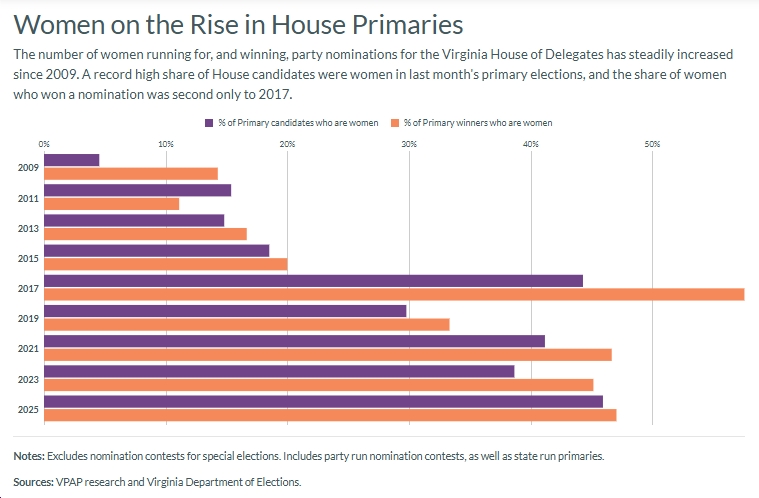There’s a VPAP graphic up on their site right now, entitled “Women on the Rise in House Primaries,” and subtitled “The number of women running for, and winning, party nominations for the Virginia House of Delegates has steadily increased since 2009.”
Sounds great, right? Yes, BUT (a big “but”)…here’s the thing, though: while it’s certainly true that the percent of women primary candidates and winners has risen since 2009, what’s really interesting is the sharp jump from 2015 to 2017. But then, they fell back in 2019, before rebounding a bit in 2021 and then basically leveling off. So the headline of this graphic, which claims that “the number of women running for, and winning, party nominations for the Virginia House of Delegates has steadily increased since 2009,” is simply not accurate – in fact, the share did NOT rise “steadily,” but more in one giant leap between 2015 and 2017.
And this giant leap from 2015 to 2016 really gets at the major flaw in the entire analysis, which is that the REASON for that giant leap between 2015 and 2017 was overwhelmingly due to a reaction, by *Democrats*, to the election of misogynistic (“grab ’em by the p***ies”) Donald Trump in November 2016. Remember the massive “Women’s March” in January 2017, which saw an estimated 500,000 march in Washington, DC, and as many as 4.6 million in the U.S. overall? Note that this was NOT called a generic “March,” and there’s a reason for that: because it was overwhelmingly organized by women and focused on women (along with male allies, of course) fighting back against Trump and for their rights, dignity, etc.
It’s also important to note that after the massive success of the Women’s March, it’s not like women’s resistance to Trump ended – quite the contrary, as basically 2017, 2018, 2019 and 2020 all were to varying degrees “the year of the woman” politically speaking, both here in Virginia and around the country, with huge numbers of women getting involved, organizing, stepping up to run for office – overwhelmingly as *Democrats*, by the way – and WINNING election to office.
Here in Virginia, for instance, the 2017 Virginia House of Delegates elections saw a slew of women running in primaries, winning the overwhelmingly majority of primaries where there were women and men running, and then helping Democrats pick up a massive 15 seats in the House of Delegates, nearly taking back that chamber. That includes 11 first-time-running-for-House-of-Delegates Democratic women elected in 2017: Jennifer Carroll Foy, Wendy Gooditis, Danica Roem, Kelly Fowler, Elizabeth Guzman, Kathy Tran, Hala Ayala, Karrie Delaney, Dawn Adams, Debra Rodman, and Cheryl Turpin. Then, in 2019, add a few more Democratic women winning election to the House of Delegates for the first time: Sally Hudson, Nancy Guy, Martha Mugler, and Shelly Simonds – as Democrats rocketed to a 10-seat (55-45) House of Delegates majority (also the first female Speaker of the House, Eileen Filler-Corn; and the first female Majority Leader, Charniele Herring; plus of course the first female President Pro Tem of the Senate, Louise Lucas). And no, there was nothing like this on the Republican side of the aisle, which in 2019 remained a heavily white male party in the House of Delegates. That was also the case in the State Senate, by the way.
So the bottom line is that the VPAP graphic is misleading, because it doesn’t break out the surge in women running (and winning) by party; if it did, it would show that this “women on the rise” phenomenon was overwhelmingly *Democratic*, with Republicans seeing nothing of the sort.
By the way, it wasn’t just the House of Delegates and State Senate, either. In 2018, for instance, there were five Democratic primaries for U.S. House where women defeated men – Vangie Williams in VA01 over two men; Leslie Cockburn in VA05 over two men, Jennifer Lewis in VA06 over two men and a woman; Abigail Spanberger in VA07 over a man; Jennifer Wexton in VA10 over five other candidates (two men, three women). And again, we didn’t see anything like this on the Republican side, where 2018 saw all four Republican members of the Virginia delegation in the US House being *male* (Rob Wittman, Denver Riggleman, Ben Cline and Morgan Griffith). Sensing a pattern here?
Anyway, the bottom line is that the whole “Women on the Rise in House [of Delegates] Primaries” is true, but only in the case of Democrats, and definitely not steadily since 2009, as the huge jump was in 2017, then to a lesser extent in 2019. As for Republicans, there are very few women (7 out of 49 Republican members) in the House of Delegates – Amanda Batten, Ellen Campbell, Carrie Coyner, Hillary Kent, Delores Oates, Anne Tata and Kim Taylor. For comparison purposes, in 2015, there were 4 Republican women in the House of Delegates (Kathy Byron, Roxann Robinson, Brenda Pogge, Margaret Ransone). So sure, the number of Republican women in the House of Delegates has increased, but only from 4 to 7 between 2015 and today, while the number of Democratic women in the House of Delegates has increased from 11 (Kathleen Murphy, Kaye Kory, Vivian Watts, Eileen Filler-Corn, Charniele Herring, Betsy Carr, Delores McQuinn, Jennifer McClellan, Roslyn Tyler, Daun Hester, Jeion Ward) in 2015 to 27 today – more than half the Democratic House of Delegates caucus!
Now that’s an interesting story, but one you definitely won’t get if you just look at the VPAP graphic. Hopefully, in the future, they’ll seriously consider breaking these out by party, because the parties’ stories are VERY different – and very much deserve to be accurately conveyed to the public.













